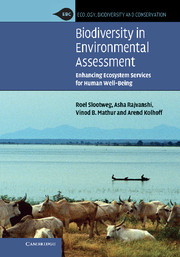Foreword
Published online by Cambridge University Press: 05 July 2014
Summary
Clean water and air, food, and shelter are the cornerstones of human well-being. Thanks to the intricate interactions between the millions of species that make up Earth's biodiversity and the many ecosystem services they provide, we can meet our basic, and not so basic, needs. Yet, the ecological footprint of humanity already exceeds Earth's capacity to regenerate and continue delivering these goods and services. Large-scale human interventions that seriously impact both biodiversity and ecosystem functions continue to increase. New policies, plans, and programmes are introduced with insufficient attention to the consequences for our living environment, even in cases where environmental assessments have been carried out. This apparent lack of attention to biodiversity in environmental assessment is not so much a deliberate decision to ignore natural processes but is rooted in the difficulties we face in adequately addressing biodiversity within the time frame and budget allocated for assessments.
This book provides a conceptual background and practical approaches to overcome these apparent difficulties. It fully integrates the objectives of the Convention on Biological Diversity, its ecosystem approach, and the conceptual framework of the Millennium Ecosystem Assessment into a comprehensive approach to biodiversity in environmental assessment. It highlights the need to consider the value of biodiversity based on its use by each stakeholder, addresses the importance of both social and economic development to reach the Millennium Development Goals, and provides insights into ways to balance present and future needs. The authors have drawn together helpful case studies that demonstrate how biodiversity can and should be integrated into environmental and strategic assessments. They provide a powerful argument that biodiversity can and must be considered to ensure that projects, programmes, and policies are culturally, environmentally, and socially acceptable. In this respect the book provides a valuable source of information for academics, and practitioners as well as decision makers.
- Type
- Chapter
- Information
- Biodiversity in Environmental AssessmentEnhancing Ecosystem Services for Human Well-Being, pp. xi - xiiPublisher: Cambridge University PressPrint publication year: 2009



